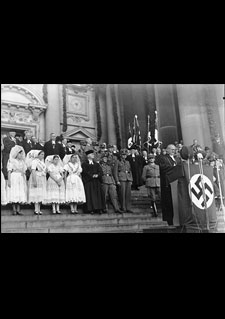The “Dictatorship of the Reich Bishop”
Criticism of Reich Bishop Ludwig Müller had increased sharply in early 1934. While the radical wing of the “German Christian Faith Movement” demanded a synthesis of Christianity and National Socialism, the opposition forming inside the church expected greater disassociation from such political endeavors.
Many felt that the Reich Bishop’s actions, initially primarily aimed at “Gleichschaltung” of the church with the state organizationally, definitely went too far. The increasing unrest in the Protestant church was a source of annoyance to the National Socialists.
After his “Reich Church cabinet” had been broken up at the end of 1933, Müller attempted to establish a kind of “dictatorship of the Reich Bishop” with the aid of new advisers, above all his “legal administrator” August Jäger and his “chief-of-staff” and “Reich vicar” Heinrich Oberheid,. The so-called “muzzle decree” of January 4, 1934 was intended to stop any criticism in the church; troublesome pastors were threatened with drastic disciplinary consequences.
Müller and his supporters as well as his critics expected the chancellor of Germany to exercise his authority in the face of the emerging unrest. On January 25, 1934, Hitler received the leading representatives of the quarreling church factions in Berlin. Hermann Göring was also present at the meeting. He read aloud a transcript of a tapped telephone call of Martin Niemöller’s, which was intended to document his political disloyalty. Müller’s critics were thus put on the defensive and once again allowed themselves to be coerced into a statement in which they avowed that they stood united behind the Reich Bishop.
Encouraged by this capitulation, Müller set about incorporating the regional churches into the Reich Church, thus going too far once and for all. Critics from different camps joined together in a “confessional front” and eventually founded the “Confessing Church” with its own leadership structures.
It is difficult to conclude where the majority of Protestants positioned themselves in this phase. At any rate, the Reich Bishop certainly had to accept a substantial loss of authority, whereas the Confessing Church experienced growing endorsement, especially in churched circles of the populace. A third group, which conducted itself “neutrally” or indifferently, certainly may not be overlooked, either. Presumably, it was even the largest group in terms of numbers, the “silent majority” so to speak.
Müller was officially installed in the “office of Reich Bishop” on September 23, 1934 in Berlin Cathedral. This official act with a symbolism supportive of the state, which can hardly be overestimated, had been postponed time and again because of conflicts. The grandiose ceremony, which undoubtedly also flattered Müller’s vanity, was intended to help him restore his weakened authority. It did not work, not for long at any rate. One clear sign of this was the deliberate absence of ecumenical representatives.

